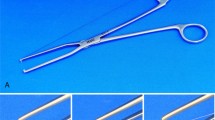Abstract
This prospective study was designed to evaluate the immediate postoperative course and long-term efficacy of septal stents. In 20 patients who underwent primary septorhinoplasty, Doyle 11 silicone stents were inserted bilaterally parallel to the septum. The stents were removed after an average of 3.3 days. A hollow tube was designed into this particular stent in an attempt to minimize patients discomfort from nasal airway obstruction. Subjective ratings of airway improvement were very similar for patients whose septums were supported with nasal stents and for those patients from our 1989 study whose noses were treated with nasal packing. However, the number of patients who complained about discomfort was substantially higher in the stent group, 60% (12 of 20), compared with the nasal packing group, 22% (5 of 23 patients) (p < 0.05). The percentage of partial residual or recurrent septal deviation was also slightly higher in the stent group, 25% (5 of 20), than in the packing group, 13% (3 of 23 patients), but this was not statistically significant (p > 0.50). The alar base incision was partially dehisced during removal of the stent in one patient, in spite of a routine reduction in the width of the splint.
Similar content being viewed by others
References
Bernal-Sprekelsen M: The postoperative nasal dressing: A new intranasal splint. Rhinology 28(3): 197–203, 1990
Campbell JB, Watson MG, Shenoi PM: The role of intranasal splints in the prevention of post-operative nasal adhesions. J Laryngol Otol 101:1140–1143, 1987
Cohen S: Postrhinoplastic intranasal adhesions. Arch Otolaryngol 54:683–692, 1951
Cook JA: Intranasal splints and their effects on intranasal adhesions and septal stability. Clin Otolaryngol 17(1):24–27, 1992
Gilchrist AG: Surgery of the nasal septum and pyramid. J Laryngol Otol 88:759–771, 1974
Guyuron B: Is packing after septorhinoplasty necessary? A randomized study. Plast Reconstr Surg 84(1):41–44, 1989
Maliniac JW: The role of the septum in rhinoplasty. Arch Otolaryngol Head Neck Surg 48:189–201, 1948
Spillman D: Aspiration von nasentamponaden mit todesfolge. Laryngol Rhinol Otolaryngol Stutt 60:56, 1981
Wagner R, Toback J: Toxic shock syndrome following septorhinoplasty using septal splints. Laryngoscope 96:609, 1986
Wallace AF: Maintenance of postoperative airway. Br J Plast Surg 15:318, 1962
Wieland H: Ober die Verbandstechnik nach plastischer gesichtschirurgie. J Med Kosmet 8:240–245, 1959
Author information
Authors and Affiliations
Rights and permissions
About this article
Cite this article
Guyuron, B., Vaughan, C. Evaluation of stents following septoplasty. Aesth. Plast. Surg. 19, 75–77 (1995). https://doi.org/10.1007/BF00209314
Issue Date:
DOI: https://doi.org/10.1007/BF00209314




